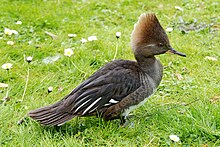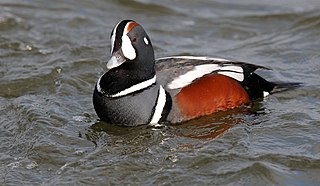
The sea ducks (Mergini) are a tribe of the duck subfamily of birds, the Anatinae. The taxonomy of this group is incomplete. Some authorities separate the group as a subfamily, while others remove some genera. Most species within the group spend their winters near coastal waters. Many species have developed specialized salt glands to allow them to tolerate salt water, but these are poorly developed in juveniles. Some of the species prefer riverine habitats. All but two of the 22 species in this group live in far northern latitudes.

The gadwall is a common and widespread dabbling duck in the family Anatidae.

The American teal or green-winged teal is a common and widespread duck that breeds in the northern areas of North America except on the Aleutian Islands. It was considered conspecific with the Eurasian teal for some time, but has since been split into its own species. The American Ornithological Society continues to debate this determination; however, nearly all other authorities consider it distinct based on behavioral, morphological, and molecular evidence. The scientific name is from Latin Anas, "duck" and carolinensis, "of Carolina".

The redhead is a medium-sized diving duck. The scientific name is derived from Greek aithuia, an unidentified seabird mentioned by authors including Hesychius and Aristotle, and Latin americana, of America. The redhead is 37 cm (15 in) long with an 84 cm (33 in) wingspan. Redhead weight ranges from 2.0 to 2.5 lbs, with males weighing an average of 2.4 lbs and females weighing an average of 2.1 lbs. It belongs to the genus Aythya, together with 11 other described species. The redhead and the common pochard form a sister group which together is sister to the canvasback.

The ring-necked duck is a diving duck from North America commonly found in freshwater ponds and lakes. The scientific name is derived from Greek aithuia, an unidentified seabird mentioned by authors including Hesychius and Aristotle, and Latin collaris, "of the neck" from collum, "neck".

The wood duck or Carolina duck is a species of perching duck found in North America. The drake wood duck is one of the most colorful North American waterfowls.

The common merganser or goosander (Eurasian) is a large sea duck of rivers and lakes in forested areas of Europe, Asia, and North America. The common merganser eats mainly fish. It nests in holes in trees.

The red-breasted merganser is a duck species that is native to much of the Northern Hemisphere. The red breast that gives the species its common name is only displayed by males in breeding plumage. Individuals fly rapidly, and feed by diving from the surface to pursue aquatic animals underwater, using serrated bills to capture slippery fish. They migrate each year from breeding sites on lakes and rivers to their mostly coastal wintering areas, making them the only species in the genus Mergus to frequent saltwater. They form flocks outside of breeding season that are usually small but can reach 100 individuals. The worldwide population of this species is stable, though it is threatened in some areas by habitat loss and other factors.

Mergus is the genus of the typical mergansers fish-eating ducks in the subfamily Anatinae. The genus name is a Latin word used by Pliny the Elder and other Roman authors to refer to an unspecified waterbird.

The common goldeneye or simply goldeneye is a medium-sized sea duck of the genus Bucephala, the goldeneyes. Its closest relative is the similar Barrow's goldeneye. The genus name is derived from the Ancient Greek boukephalos, a reference to the bulbous head shape of the bufflehead. The species name is derived from the Latin clangere.
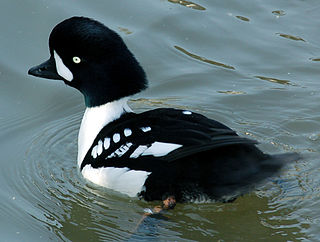
Barrow's goldeneye is a medium-sized sea duck of the genus Bucephala, the goldeneyes. This bird was named after Sir John Barrow. The genus name is derived from Ancient Greek boukephalos, "bullheaded", from bous, "bull" and kephale, "head", a reference to the bulbous head shape of the bufflehead. The species name islandica means Iceland.

The bufflehead is a small sea duck of the genus Bucephala, the goldeneyes. This species was first described by Carl Linnaeus in his landmark 1758 10th edition of Systema Naturae as Anas albeola.

The surf scoter is a large sea duck native to North America. Adult males are almost entirely black with characteristic white patches on the forehead and the nape and adult females are slightly smaller and browner. Surf scoters breed in Northern Canada and Alaska and winter along the Pacific and Atlantic coasts of North America. Those diving ducks mainly feed on benthic invertebrates, mussels representing an important part of their diet.

The mountain bluebird is a migratory small thrush that is found in mountainous districts of western North America. It has a light underbelly and black eyes. Adult males have thin bills and are bright turquoise-blue and somewhat lighter underneath. Adult females have duller blue wings and tail, grey breast, grey crown, throat and back. In fresh fall plumage, the female's throat and breast are tinged with red-orange which is brownish near the flank, contrasting with white tail underparts. Their call is a thin 'few' while their song is a warbled high 'chur chur'. The mountain bluebird is the state bird of Idaho and Nevada. This bird is an omnivore and it can live 6 to 10 years in the wild. It eats spiders, grasshoppers, flies and other insects, and small fruits. The mountain bluebird is a relative of the eastern and western bluebirds.

Cassin's finch is a bird in the finch family, Fringillidae. This species and the other "American rosefinches" are placed in the genus Haemorhous.

The yellow-headed blackbird is a medium-sized blackbird with a yellow head.
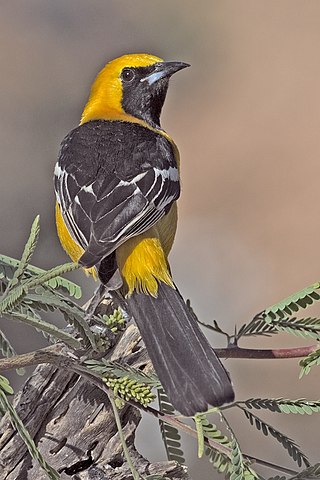
The hooded oriole is a medium-sized New World oriole. The male of this species ranges in color from a bright orange to a paler yellow, with a black back, face, tail and bib, with the wing containing two white bars. The female is more of an olive color with some yellow accents.

The olive-sided flycatcher is a small to medium sized passerine bird in the family Tyrannidae, the Tyrant flycatcher family. It is a migratory species that travels from South to North America to breed during the summer. It is a very agile flyer and mainly consumes flying insects on flight. Since 2016, this species has been assessed as being near-threatened globally (IUCN) and threatened in Canada (SRA) due to its declining populations.

The scaly-sided merganser or Chinese merganser is an endangered typical merganser. It lives in Manchuria and extreme Southeast Siberia, breeding in the north and wintering in the south.
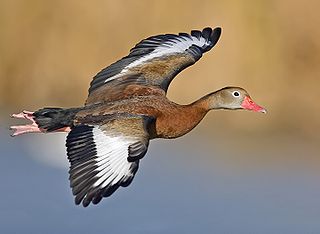
The black-bellied whistling duck, formerly called the black-bellied tree duck, is a whistling duck that before 2000 bred mainly in the southernmost United States, Mexico, and tropical Central to south-central South America. It can be found year-round in much of the United States. It has been recorded in every eastern state and adjacent Canadian province. Since it is one of only two whistling duck species native to North America, it is occasionally just known as the "whistling duck" or "Mexican squealer" in the southern USA.




